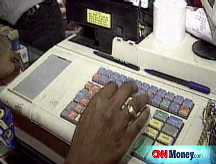Inflation: Price jump worst since '91
Record gas and higher costs prices spark a 5% annual jump in Consumer Price Index.
NEW YORK (CNNMoney.com) -- Record gas and higher food prices drove inflation to the biggest annual jump since 1991 and fanned fears about growing pressures on consumers.
The Labor Department reading on Wednesday is another sign, along with mounting job losses and declining home prices, of the economic pain suffered by Americans as prices outstrip increases in paychecks.
The latest reading came as Federal Reserve Chairman Ben Bernanke, in testimony on Capitol Hill, was warning that inflation could pose a major drag on the economy for the rest of this year.
Retail prices were up 5% annually in June, the biggest 12-month change since May 1991 - an annual figure that was skewed by the surge in gasoline prices related to the first Gulf War.
A separate Labor Department report showed the average hourly wage up only 3.4% over the same 12-month period, meaning the typical American is having trouble keeping up with the price increases.
"The government report confirms what every consumer in America has known for months now: inflation is soaring and it's having an adverse impact on the economy," said Rich Yamarone, director of economic research at Argus Research.
On a monthly basis, the Consumer Price Index was up 1.1% in June, after a 0.6% rise in May. Economists surveyed by Briefing.com had been looking for only a 0.7% rise.
Energy prices were up 6.6% in the month, led by a 10.1% jump in gas prices. That left gasoline prices up nearly a third from a year earlier.
But there was also pain at the grocery store for many Americans, as food prices jumped 0.8% compared to May, led by a 2.8% jump in fruits and vegetables, and a 1.6% rise in dairy and related products.
The rise left grocery prices up 6.1% compared to a year ago, with cereals and bakery products posting one of the biggest year-over-year gains, up 10.4%.
Yamarone said that he believes inflation could remain at elevated levels for the next six to nine months, even if oil prices retreat from current levels.
"I wouldn't be surprised if we creep up to 6, 7 even 8%," he said.
The so-called core CPI, which excludes volatile food and energy prices, rose 0.3%, after a 0.2% rise. Economists had been looking for another 0.2% rise. The higher than expected core reading was also troubling because that could tie the Fed's hands in its effort to help the struggling economy.
The 12-month rise in core CPI is now up 2.4%, up from a 2.3% rise in that reading in May.
Bernanke warned lawmakers on Tuesday and again on Wednesday that inflation poses a risk for the economy.
"Rapid increases in the prices of energy and other commodities ... have sapped household purchasing power even as they have boosted inflation," he said in testimony.
He also warned that spending by consumer spending, which provides nearly three-quarters of the nation's economic activity, "seems likely to be restrained over coming quarters" and that price increases could also make businesses cautious about their own spending plans.
One measure of the economic stress on households is the so-called economic misery index - calculated by adding the 12-month inflation rate and the unemployment rate. With the jump in inflation to 5% in June from 4.2% in May, the misery index is now at 10.5, the first time it has hit double digits since 1993.
While the Federal Reserve responded to economic pain earlier this year by approving deep interest rate cuts, it's not clear the central bank will be providing any more help to help households in the foreseeable future.
The Fed generally wants to see core inflation measures up between 1% and 2%, so the new core reading was well outside the so-called comfort zone.
Bernanke said in his congressional testimony that despite the weak outlook for economic growth, the Fed could not ignore signs of rising inflation. The Fed's strongest measure to spur economic growth, interest rate cuts, are seen as adding to inflation pressure. ![]()


